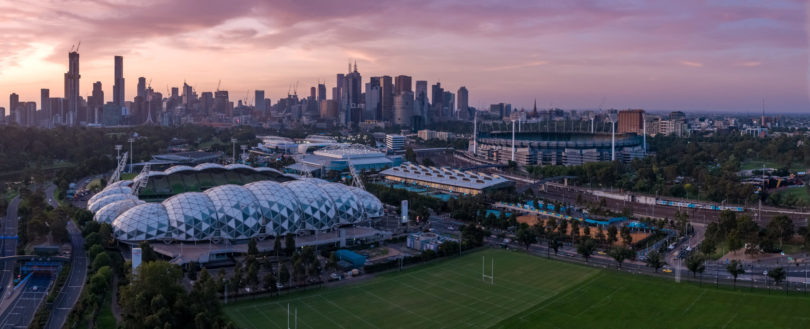In Australia, drones are slowly but surely gaining popularity in the AEC (Architecture, Engineering & Construction) industries. According to a report by Deloitte prepared for the Australian Government, drone surveying was found to be a cost-effective and hassle-free alternative compared to traditional resource-intensive land surveying methods.
Drone surveying, when done right, also promotes worksite safety. Certified drone pilots can easily capture clear aerial footage of project sites, rooftops, towers and more to get an accurate view of hard to reach spots in an industrial facility, without having to risk sending a person to these locations for inspection.
However, these little flying machines can do so much more than just take cool pictures. They work both indoors and outdoors. Specialised commercial drones are popularly used for land surveying, terrain mapping, site inspection, and videography. Their applications extend to any requirement which benefits from a pair of eyes from the top.
Drone surveying and mapping technologies serve as a new-age multipurpose tool that offers AEC professionals the potential to reimagine landscapes, create 3D models, and build innovative on-site solutions.
If the sky’s the limit, then drones indeed give you the perfect view!
Here are 9 ways drone technologies can help boost businesses across all sectors and industries.
1. Drone Photography
At present, businesses use drones to take attractive aerial shots and panoramic shots of their offices, high rise buildings and on-site projects.
These pictures are used for promotional campaigns, creating marketable e-books, company brochures, case studies and any other materials primarily for marketing purposes.
Depending on the type of drone you are using, you can take aerial shots of the site from multiple angles and altitudes leading to some breath-taking results.
With drones, businesses now have the creative freedom to capture the project in ways that simply wasn’t possible earlier.
2. Videography
The entertainment industry was quick to join the drone bandwagon. A lot of media houses are now using drones to improve the quality of the shots taken on set.
Camera mounted drones are also a lot less expensive than some of the high-end cameras used to capture moving footage.
Plus, the fact that drones are smaller and more convenient to handle make them a universal favourite.
Businesses often turn to drone cameras when shooting promotional ads, short Facebook ads, explainer videos and more.
In non-commercial spaces, drones have also been an interesting addition for wedding ceremonies, capturing the venue and the guests from different captivating shots.
3. Land Surveys and inspection
A bird’s eye view helps contractors get better insights on the construction site. Drones take a lot less time, covering hundreds of acres in the span of a few hours is a major advantage.
Usually, construction site inspection using drones takes a couple of days when using traditional surveying methods. Drones also provide for more accurate measurements and help on-site engineers make quicker decisions.
You don’t have to visit the site as often either. Normally a drone pilot, with a remote pilot license from the Civil Aviation Safety Authority, supervises the drone on-site and sends regular reports directly to your system.
The raw footage data collected by drones is then processed in a photogrammetry software to generate vector maps and 3D models.
These maps and models, created using drone mapping and digital imaging techniques, come in handy when you’re creating land titles or project blueprints.
4. Worksite safety
For manufacturing companies, drones are a lifesaver! Usually, business owners have to spend a significant amount of time inside these manufacturing units to ensure that everything is running smoothly.
The Civil Aviation Safety Authority (CASA) have set up their own guidelines for safe usage of drones across Australia. They register drones and certify drone pilots to ensure a safe and secure implementation of drone technologies across all industries.
The on-site manager or contactor also has to keep an eye on the raw materials and maintain a regular inventory of the resources used everyday
With drones, this process seems a lot less taxing. You don’t have to physically check every aspect of the site. instead, you let the drone do all the hard work for you.
Drones can reach high rise areas, inspect rooftops, narrow crevices, small pipelines, etc. without putting anyone else in a dangerous situation.
In construction sites and mining quarries, drones gather information from narrow caves, under bridges, dams, and other spaces.
5. Transparent Reporting
Drones have also been a blessing for businesses that require large volumes of data mapping.
UAVs also help with warehousing and tracking inventory. Before drones, workers had to track the on-site materials. Contractors can now identify missing stock in minutes.
Drones also help with bookkeeping and maintaining financial records for year-end accounting.
6. Procuring resources
For engineers, half the trouble is finding the most accessible and suitable resources. Using UAVs, engineers can discover new sources to find raw materials nearby the manufacturing site.
Drones can go deep down inside quarries, inspect oil wells, refineries, analyse transmission lines and other places that might not be safe for humans.
Rather than collecting data from the ground, drones can capture aerial footage of specific ground points from various angles. You can even control the speed, altitude of the drone and the angle at which the footage must be captured.
This gives you a clearer picture of the elevations, topography and even soil gradation of the site.
Plus, this drone data is compatible with almost every popular workflow management system.
7. Drones in Real Estate
Another important sector involving drones is real estate. Most property owners have their properties listed online on real estate websites. Most buyers expect to see photos, videos and even 3D tours of the property. And this is where drones shine the most!
Today, you can use advanced drones for the job.
With UAV drones, you can easily capture stunning images and record short length footage of the property that increases the value of your listing.
It also allows for greater flexibility as you can decide the angles, flight altitude and define the ground control points that would act as a frame of reference.
The drone footage thus collected can be used to generate realistic 3D maps and models.
UAVs are also used for on-site property inspection and cost evaluation. The buyer can see the current condition of the property and take the judgement call.
8. Insurance Evaluation
Insurance companies use drones to evaluate real estate properties and other assets. They are a far more convenient, cost-effective alternative to manual inspections.
Also, the chances of missing out crucial details is higher during physical property surveys. With drones, you can effectively capture every corner of the property and take footage from multiple angles.
This gives the insurance agent a clear view of the damages, weak spots around the site which in turn affects the overall coverage and insurance claims.
9. Drone Delivery
Finally, drones are also used to transport lightweight goods from one place to another within the perimeters of the site.
Depending on its size and scalability, drones can carry limited weights. This comes in handy during on-site injuries. You can use drones to send first aid supplies to the accident site.
Recently, companies like Amazon and Google are using drones to deliver packages across short distances.
It will be a while before this starts happening in Australia.
For now, the growing awareness and curiosity about drones in AEC industries and other business sectors.
The Bottom Line
Unmanned aerial vehicles (UAV) better known as drones, are the new thing that everyone is talking about. Those who have it, flaunt it. Those who don’t, want it!
From real estate properties to construction sites and filmmaking sets, drones are pretty much everywhere. Drones are reinventing businesses and creating new opportunities for ventures across all sectors and industries.
I hope that these points give you a better insight into drone tech and inspire you to explore the limitless applications of drones!
“The opinions expressed by BizWitty Contributors are their own, not those of BizCover and should not be relied upon in place of appropriate professional advice. Please read our full disclaimer."







